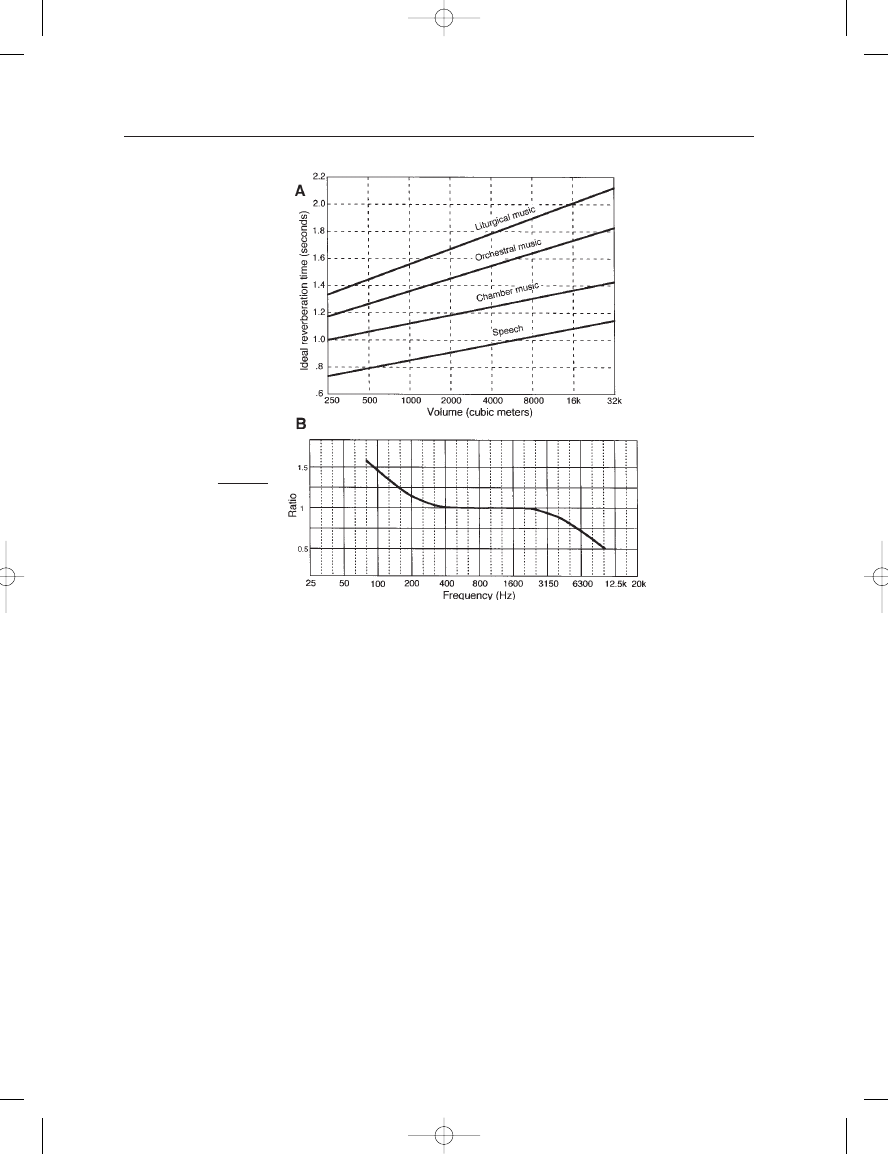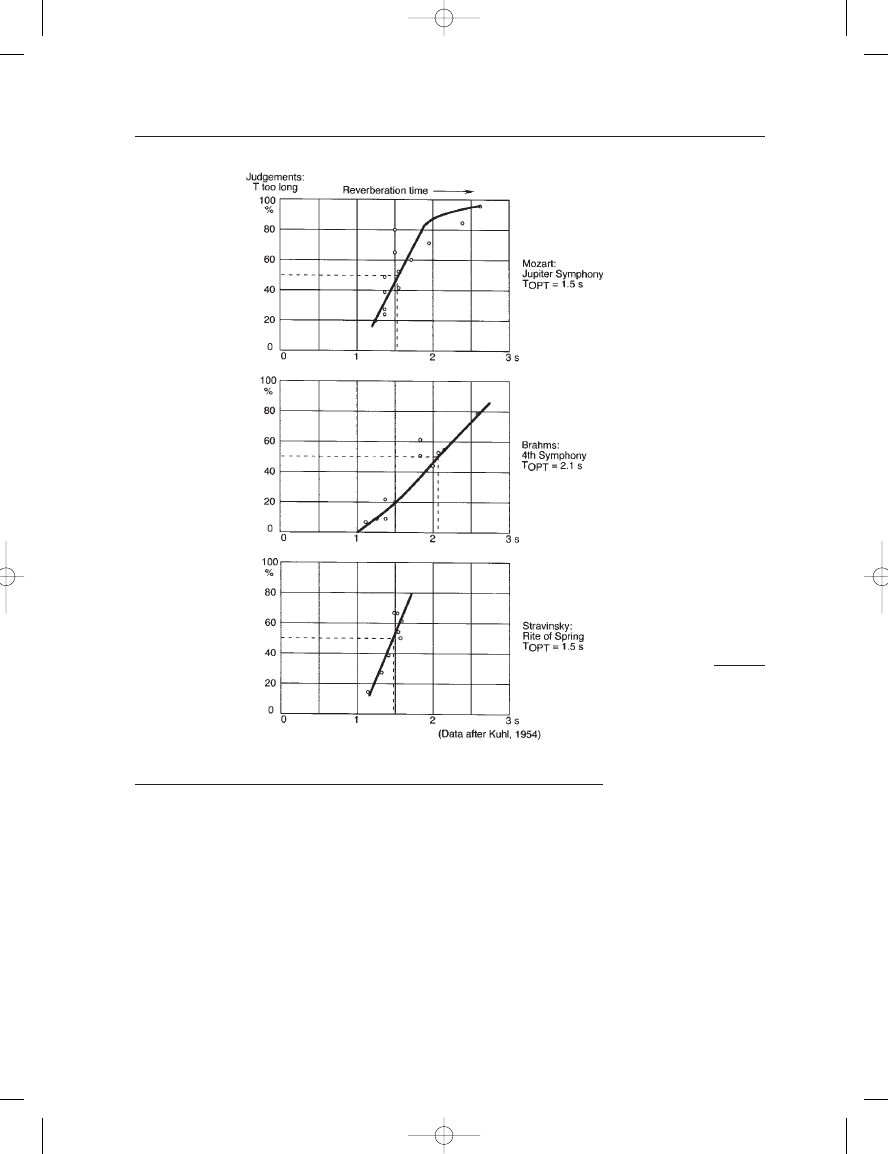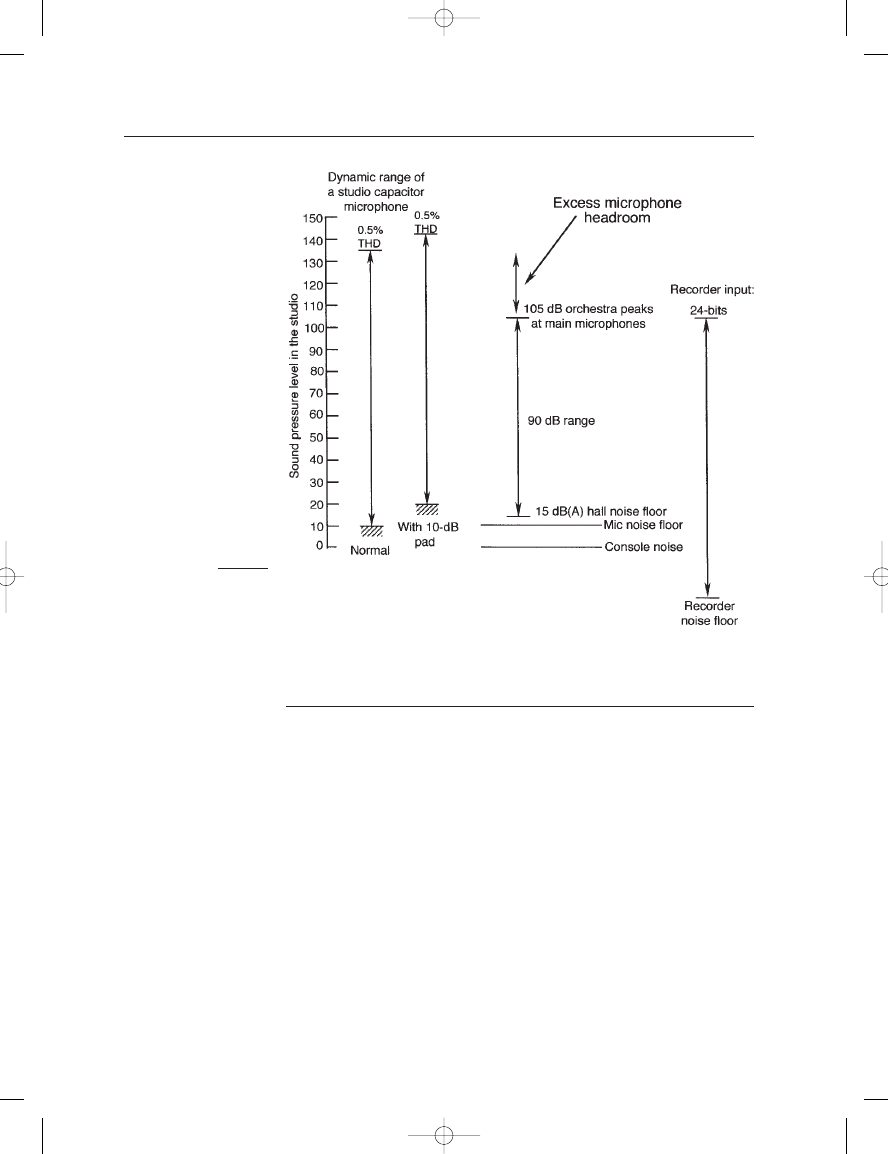ВУЗ: Казахская Национальная Академия Искусств им. Т. Жургенова
Категория: Книга
Дисциплина: Не указана
Добавлен: 03.02.2019
Просмотров: 17295
Скачиваний: 51

Once the target reverberation time has been established, the amount
of reverberation introduced into the recording is critical. The sound
picked up by the house microphones and introduced into the stereo mix
will determine this ratio. This is an area where accurate loudspeaker
monitoring conditions and experience on the part of both engineer and
producer are of primary importance. In many cases, this important
judgement is not made until the postproduction stage.
MAINTAINING A CONSISTENT FORE-AFT PERSPECTIVE
It is up to the engineer and producer to determine the effective “distance”
of the pickup, relative to the stage, and make it convincing. Rather than
placing microphones at Row J, we make the recording fairly close-in, and
then we introduce reverberation to “zoom out” to where we want it to
be. A slight increase in the amount of signal from the house microphones
will result in a surprising increase in effective distance, so care should be
taken in making these balances. When musical reasons justify this, it may
be desirable to pan in the main flanking microphones very slightly toward
the center, just to give the direct stage pickup a slightly narrower image to
match the increase in apparent fore–aft distance. If this is not done, we
run the risk of making a recording with conflicting spatial cues; it may
sound both close-in and distant at the same time.
13: Classical Stereo Recording Techniques and Practice
213
FIGURE 13–17
Typical reverberation times
versus room volume for
various types of music (A);
normal variation of LF and
HF reverberation times
compared with the
midband (B).
Earg_13.qxd 14/9/04 2:53 PM Page 213

DYNAMIC RANGE ISSUES
As we have seen in previous chapters, today’s quality capacitor micro-
phones may have dynamic ranges well in excess of 125 dB. However, in
classical recording, we are rarely able to take advantage of more than
about 90 or 95 of those precious decibels, as illustrated in Figure 13–19.
As we can see, the noise floor of a modern quiet venue is just about
at the same effective level as the self-noise floor of the primary micro-
phones themselves. As the amplified signals from the microphones are
transmitted downstream to a digital recorder, the noise floor limitation
in the recording remains that of the microphones and the room.
Thus, the choices of both venue and microphones remain all impor-
tant. Microphones with self-noise in the range of 7 to 13 dB(A) are
strongly recommended for all classical orchestral recording.
THE MICROPHONE BOOK
214
FIGURE 13–18
Kuhl’s data on preferred
recorded reverberation
times for three orchestral
works.
Earg_13.qxd 14/9/04 2:53 PM Page 214

COMPACT DISC REFERENCES
1. Singing on the Water, Delos CD DE 3172, Carol Rosenberger,
piano. Recorded with two spaced omnidirectional microphones.
2. Bach: Violin Sonatas and Partitas, Arranged for Guitar, Delos CD
DE 3232, Paul Galbraith, guitar. Recorded with two spaced omni-
directional microphones.
3. Things Visible and Invisible, Delos CD DE 3147, Catharine
Crozier, organ. Recorded with two omnidirectional microphones
spaced about 4 m at a distance of 10 m.
4. Arensky/Tchaikowsky Piano Trios, Delos CD DE 3056, Golabek,
Solow, Cardenes Trio. Recorded as detailed in Figure 14–8B.
5. Love Songs, Delos CD DE 3029, Arleen Augér, soprano. Recording
made as shown in Figure 14–9. Some room reverberation added.
6. Mendelssohn/Grieg String Quartets, Delos CD DE 3153, Shanghai
Quartet. Recorded as shown in Figure 14–10C.
13: Classical Stereo Recording Techniques and Practice
215
FIGURE 13–19
Dynamic range of
recording microphones in a
concert venue.
Earg_13.qxd 14/9/04 2:53 PM Page 215

7. Haydn, Symphonies 51 and 100, Delos CD DE 3064, Gerard
Schwarz conducting the Scottish Chamber Orchestra. Recorded
as shown in Figure 14–12.
8. Holst, The Planets (coupled with Strauss: Also Sprach
Zarathustra), Delos CD DE 3225, Andrew Litton conducting the
Dallas Symphony Orchestra. Recorded as detailed in
Figure 14–13.
9. Shostakovich, Piano Concerto no. 2, Delos CD DE 3246, Andrew
Litton, pianist and conductor, Dallas Symphony Orchestra.
Recorded as shown in Figure 14–15A, but with main ORTF piano
between piano and audience.
10. Mahler, Symphony no. 2, Delos CD DE 3237, Andrew Litton,
Dallas Symphony Orchestra and Chorus. Recorded as shown in
Figure 14–15B, with two vocal soloists on either side of the con-
ductor and with chorus located in choral terrace behind and at
sides of the orchestra.
11. Second Stage, Delos CD DE 3504, various orchestral movements
to demonstrate recording perspectives. Band 2 recorded in
Portland, OR, concert hall without livening; band 12 recorded in
same hall with livening technique as discussed in Figure 13–16.
THE MICROPHONE BOOK
216
Earg_13.qxd 14/9/04 2:53 PM Page 216

C
H
A
P
T
E
R
1
4
STUDIO RECORDING
TECHNIQUES
INTRODUCTION
Most recordings of commercial music originate not in traditional
performance venues but in professional recording studios. Most studios
used for pop and rock recording are large enough to accommodate no
more than 12 to 20 musicians comfortably, and only in large metropoli-
tan centers will we find large sound stage environments that can accom-
modate a 50- to 75-piece orchestra. For the most part, microphone
placement in these studios is much closer to the instruments than is usual
in classical recording, and there is much more usage of accent micro-
phones. In virtually all cases there will be extensive use of multitrack
recording, which allows for greater flexibility in postproduction.
In this chapter we will discuss a wide range of recording activities
and supporting functions that routinely take place in the studio. We will
also discuss aspects of studio acoustical treatment and arrangements for
instrumental isolation, both individually and in groups.
We will also develop in this chapter the notion of recording as an art
in its own right and not as a simple documentation of an acoustical
event. Many of our recommendations in balance and panning may seem
to be arbitrary, but their effectiveness in two-channel stereo playback
justifies them.
The modern studio should have a modern control room, fitted with
monitor loudspeakers that are symmetrically arrayed around the primary
workspace. They may be built in, or they may be placed on stands. It is
important that they exhibit essentially flat response over the frequency
range out to about 6 or 8 kHz, with no more than a slight rolloff above
that frequency. The response in both channels should be within about
2 dB of each other from about 100 Hz to about 8 kHz, and the systems
should be able, on a per-channel basis, to reproduce cleanly midband
signals of 105 dB at the engineer’s operating position.
Earg_14.qxd 14/9/04 2:54 PM Page 217